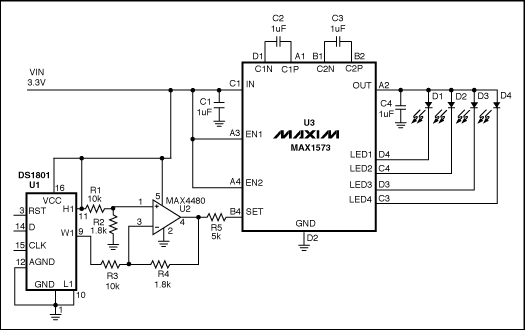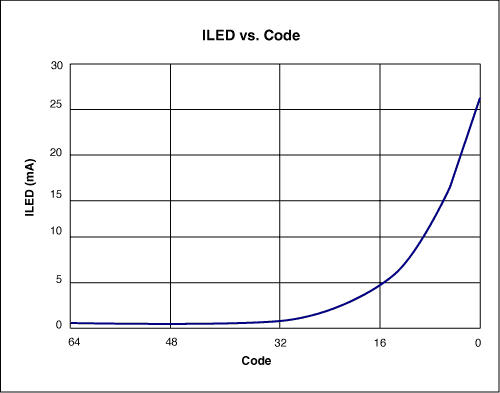The circuit of Figure 1 is designed for portable-power applicaTIons that require white LEDs with adjustable, logarithmic dimming levels. It drives as many as four white LEDs from a 3.3V source, and adjusts the total LED current from 1mA to 106mA in 64 steps of 1dB each. The driver is a charge pump that mirrors the current ISET (sourced from U3's SET terminal), to produce a current of (215ISET ± 3%) through each LED. Internal circuitry maintains the SET terminal at 0.6V.

Figure 1. This circuit provides a logarithmic-dimming capability for white LEDs.
To control the LED brightness, op amp U2 monitors the difference between the high-side voltage and the wiper voltage of digital potenTIometer U1. The op amp then mulTIplies that voltage by a gain to set the maximum output current. Zero resistance at the pot's W1 terminal corresponds to minimum LED current, and therefore minimum brightness. Because the SET voltage is fixed (at 0.6V), any voltage change at the left side of R5 changes ISET, and the resulTIng change in LED currents changes their brightness level. R5 sets the maximum LED current:
R5 = 215x0.6 / ILED (Desired)
where ILED is the current through one LED.
U1 is a digital potentiometer with logarithmic taper and an analog-voltage wiper for which each tap corresponds to 1dB of attenuation between H1 and W1 (pins 11 and 9). It contains two pots controlled by a 16-bit code via a 3-wire serial interface. To set the LED current, drive RST-bar high and clock 16 bits into the D terminal of U1, starting with the LSB. Each pulse at CLK enters a bit into the register.
The circuit uses only one pot, so bits 0 through 7 are "don't care" bits. Bits 8 through 14 determine the wiper position: bits 8 through 13 set the code, and bit 14 is "mute." (Logic one at bit 14 produces the lowest-possible output current by setting the left side of R5 at approximately 0.599V.) After entering all 16 bits, enter the code and change the brightness level by driving RST-bar high. Figure 2 shows the logarithmic relationship between an LED current and the pot's input code.

Figure 2. LED current vs. input code for the Figure 1 circuit.
This design idea appeared in the June 10, 2004 issue of EDN magazine.
Benefits of Privacy Screen Protectors
As a personal item, a mobile phone will always contain all kinds of private information and secrets. Therefore, when many people use their mobile phones in public places, they are worried that their screen content will be seen by the people next to them. Especially when you use your mobile phone to enter various passwords, it is very dangerous if you are targeted by malicious people.
In order to prevent private information and confidential documents from being peeped, Privacy Screen Protector came into being. As the name suggests, it is a Mobile Phone Screen Protector, which can prevent others from prying on the screen and protect personal privacy. When you install a Privacy Screen Protector on your phone, people around you won't be able to see what's on your screen.
The Anti-Spy Screen Protector uses patented ultra-fine louver optical technology, so that the information on the screen is displayed on the front for the user to read. The viewable area is 60 degrees. Anyone can only see the dark picture on both sides. And the anti-blue light effect of the Privacy Screen Protective Film, the blue light blocking rate is about 10%-30%, and the mobile phone with the Privacy Film will automatically darken to reduce some glare. Therefore, normal use will not hurt the eyes, but will play a protective role. Anti-peeping Screen Protector effectively protect business secrets and personal privacy. Whether it is work, study, communication or entertainment, it makes the use of computers and mobile phones more free. Help the company's senior business personnel, lawyers, consultants, financial personnel, etc. to avoid screen information leakage when using mobile phones.
Anti-Peep Hydrogel Screen Protector,Anti-Spy Tpu Hydrogel Film,Privacy Hydrogel Protector,Privacy Screen Protector Sheet
Shenzhen TUOLI Electronic Technology Co., Ltd. , https://www.szhydrogelprotector.com